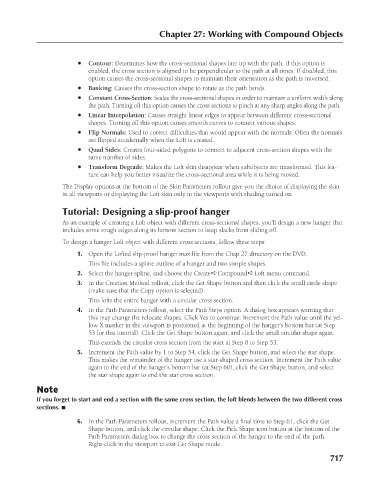Page 765 - Kitab3DsMax
P. 765
Chapter 27: Working with Compound Objects
l Contour: Determines how the cross-sectional shapes line up with the path. If this option is
enabled, the cross section is aligned to be perpendicular to the path at all times. If disabled, this
option causes the cross-sectional shapes to maintain their orientation as the path is traversed.
l Banking: Causes the cross-section shape to rotate as the path bends.
l Constant Cross-Section: Scales the cross-sectional shapes in order to maintain a uniform width along
the path. Turning off this option causes the cross sections to pinch at any sharp angles along the path.
l Linear Interpolation: Causes straight linear edges to appear between different cross-sectional
shapes. Turning off this option causes smooth curves to connect various shapes.
l Flip Normals: Used to correct difficulties that would appear with the normals. Often the normals
are flipped accidentally when the Loft is created.
l Quad Sides: Creates four-sided polygons to connect to adjacent cross-section shapes with the
same number of sides.
l Transform Degrade: Makes the Loft skin disappear when subobjects are transformed. This fea-
ture can help you better visualize the cross-sectional area while it is being moved.
The Display options at the bottom of the Skin Parameters rollout give you the choice of displaying the skin
in all viewports or displaying the Loft skin only in the viewports with shading turned on.
Tutorial: Designing a slip-proof hanger
As an example of creating a Loft object with different cross-sectional shapes, you’ll design a new hanger that
includes some rough edges along its bottom section to keep slacks from sliding off.
To design a hanger Loft object with different cross sections, follow these steps:
1. Open the Lofted slip-proof hanger.max file from the Chap 27 directory on the DVD.
This file includes a spline outline of a hanger and two simple shapes.
2. Select the hanger spline, and choose the Create ➪ Compound ➪ Loft menu command.
3. In the Creation Method rollout, click the Get Shape button and then click the small circle shape
(make sure that the Copy option is selected).
This lofts the entire hanger with a circular cross section.
4. In the Path Parameters rollout, select the Path Steps option. A dialog box appears warning that
this may change the relocate shapes. Click Yes to continue. Increment the Path value until the yel-
low X marker in the viewport is positioned at the beginning of the hanger’s bottom bar (at Step
53 for this tutorial). Click the Get Shape button again, and click the small circular shape again.
This extends the circular cross section from the start at Step 0 to Step 53.
5. Increment the Path value by 1 to Step 54, click the Get Shape button, and select the star shape.
This makes the remainder of the hanger use a star-shaped cross section. Increment the Path value
again to the end of the hanger’s bottom bar (at Step 60), click the Get Shape button, and select
the star shape again to end the star cross section.
Note
If you forget to start and end a section with the same cross section, the loft blends between the two different cross
sections. n
6. In the Path Parameters rollout, increment the Path value a final time to Step 61, click the Get
Shape button, and click the circular shape. Click the Pick Shape icon button at the bottom of the
Path Parameters dialog box to change the cross section of the hanger to the end of the path.
Right-click in the viewport to exit Get Shape mode.
717

